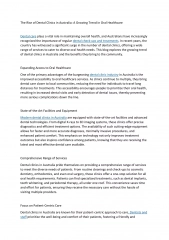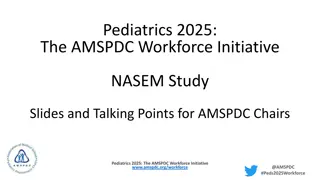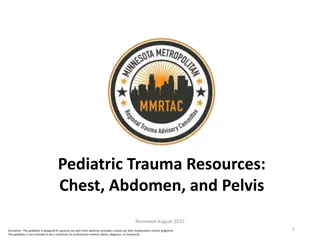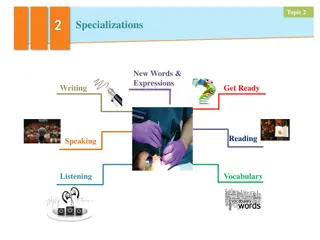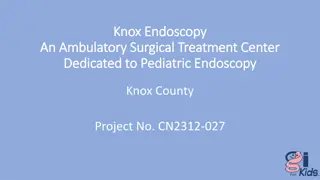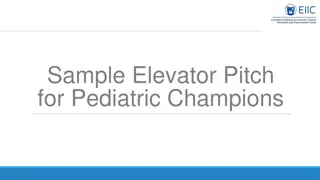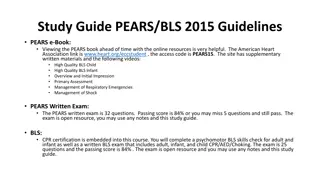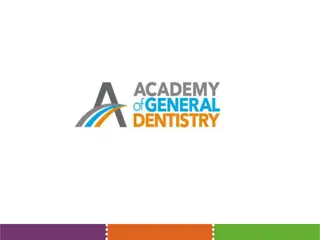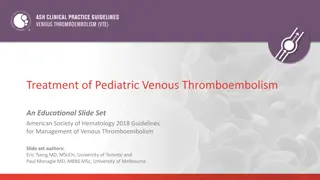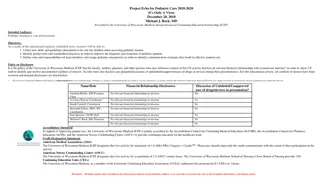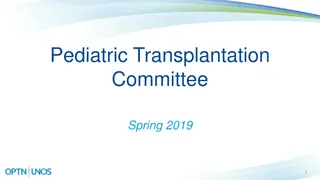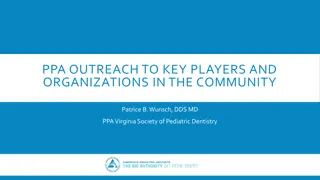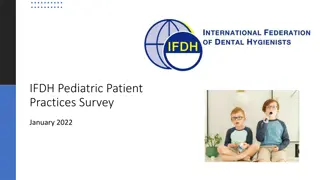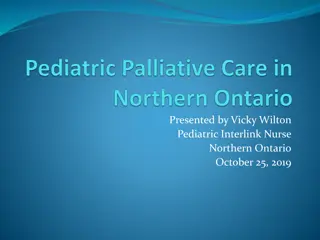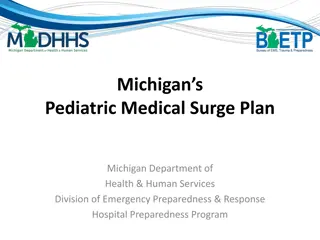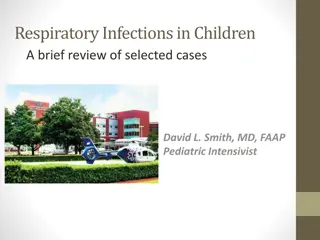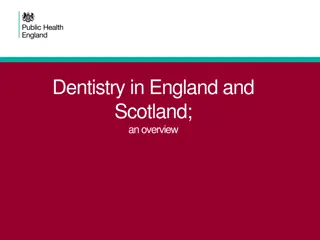Effective Communication Strategies in Pediatric Dentistry
In pediatric dentistry, communicative management plays a crucial role in successfully managing both cooperative and uncooperative children. It involves utilizing verbal and non-verbal communication techniques to establish a comfortable and relaxed interaction with the young patients, creating a positive environment for dental care. Techniques like voice control, euphemisms, reframing, and behavior shaping are employed to ensure effective communication and cooperation during dental procedures.
Download Presentation

Please find below an Image/Link to download the presentation.
The content on the website is provided AS IS for your information and personal use only. It may not be sold, licensed, or shared on other websites without obtaining consent from the author.If you encounter any issues during the download, it is possible that the publisher has removed the file from their server.
You are allowed to download the files provided on this website for personal or commercial use, subject to the condition that they are used lawfully. All files are the property of their respective owners.
The content on the website is provided AS IS for your information and personal use only. It may not be sold, licensed, or shared on other websites without obtaining consent from the author.
E N D
Presentation Transcript
COMMUNICATIVE MANAGEMENT First objective in the successful management of a child is to establish communication. -McDonald & Avery(1978) Communicative management is universally used in pediatric dentistry with both the cooperative & uncooperative child. - Chambers (1976) 2
TYPES OF COMMUNICATION- a) Verbal communication b) Non-verbal (multisensory communication) is by: - Body language - Smiling - Eye contact - Expression of feelings without speaking - By touching the child - Giving him a pat - Giving a hug c) Both using verbal & nonverbal 3
How to communicate? Communication should be comfortable & relaxed. Language should contain words that express pleasantness, friendship & concern. --Korch (1972) Verbal communication for younger children, more than 3years of age. And non-verbal communication in less than 3years. Tone of Voice should be constant & gentle. 4
Voice control should express empathy & firmness. Content should be such that the child feels that we are his well wishers. Patient should be addressed by his name Compliment him about his appearance. Ask questions about his likes-dislikes.
USE OF EUPHEMISMS: these are substitute words. Rubber dam Rain coat Rubber dam clamp Tooth button Rubber dam frame Coat rack Sealant Tooth paint Topical fluoride gel Cavity fighter Air syringe Wind gun Water syringe Water gun Suction Vacuum cleaner Alginate Pudding Study models Statues High speed Whistle Low speed Motorcycle 6
Reframing: Given by Benjamin Peretz (1999) It is defined as taking a situation outside the frame that up to that moment contained the individual in different conditions, & visualize (reframe) it in a way acceptable to the person involved, so that the threatened situation can be abandoned. 7
BEHAVIOR SHAPING 1. DESENSITIZATION: Given by Joseph Wolpe,(1969) Used to remove fears & anxiety in children with previous unpleasant dental experience or negative behavior. Is accomplished by teaching the child a competing response such as relaxation & then introducing progressively more threatening stimuli. E.g. Tell-Show-Do technique. 8
Tell-Show-Do Technique (TSD): Given by Addleston (1959) Tell & show every step & instrument & explain what is to be done. From least fear promoting object or procedure to more fearful objects. Indications- First visit -Introducing new dental procedure -Fearful child Technique Effective in children > 3years of age. 9
2. Modeling: Given by Bandura,1969 Developed Social- principle, procedure. TECHNIQUE- allowing a patient to observe one or more (models) demonstrate a positive behavior in a situation. Modelling can be done by- Live models Filmed models Posters Audiovisual aids from learning individuals who 10
3. Contingency management: Method of modifying the behavior of children is by presentation or withdrawal of reinforcers. a) Positive reinforcer- is one whose contingent presentation increases the frequency of behavior. -- Given by Henry W. Fields(1984) E.g. child rewarded for a good behavior 11
b) Negative reinforcer- whose contingent withdrawal increases the frequency of behavior . It is termination of aversive stimulus. -- By Stokes & Kennedy (1980) E.g. Withdrawal of the mother 12
Types of reinforcers- a) Social- e.g. praise, positive facial expression, shaking hand, patting shoulder or back. b) Material- e.g. toys, games, comics. Sweets are not given as reward. c) Activity reinforcer - watching t.v. 13
BEHAVIOR MANAGEMENT 1. Audio analgesia: Given by Gardner, Licklider(1959) Also called as White-noise . Is a method of reducing pain by providing sound stimulus of such intensity that patient finds it difficult to attend to anything else. E.g. auditory stimulus to reduce stress 14
2. Biofeedback: Given by Buonomono (1979) Involves use of certain instruments to detect certain processes associated with fear. e.g. Blood pressure Electroencephalogram, to control anxiety & stress. physiological instrument, 15
3. Humor : Helps to elevate the mood of the child, which helps the child to relax. Functions- a) Social- Forming a relationship b) Emotional- Anxiety relief in child, parent. c) Informative- Telling information in a non threatening way. d) Cognitive- distraction from fearful stimuli. 16
4. Coping: Given by Lazaue (1980) Defined as the cognitive & behavioral efforts made by an individual to master, tolerate or reduce stressful situations. Patients under stress prefer to draw comfort from the doctor/nurse. 17
2 types a) Behavioral - physical or verbal activities b) Cognitive child tries to keep calm. - Reality oriented thinking - Cognitive reappraisal - Emotion regulating cognitions. Given by Sandra L Curry (1988). 18
Signal system: Given by Musslemann (1991). As a part of coping, we ask the child to raise his hand, when it hurts during the procedure. Usual coping mechanisms include: friendliness, support, reassurance. 19
5. Voice control: Modification of intensity & pitch of one s own voice in an attempt to dominate the interaction between the dentist & child. Change in voice from gentle to firm for child s attention & to remind that dentist is an authority figure. Used with physical restraints & hand over mouth exercise (HOME). Given by Henry & Marilyn (1984) 20
6. Relaxation: To reduce stress . Based on the principle of elimination of anxiety. Involves a series of basic exercises which require the patient to practice at home for atleast 15 minutes. 21
Relaxation techniques for relief of anxiety/ stress in dental office 1. Focusing The attention on a small personal object which is of great interest to the patient. 2. Meditation- Sit or lie in a comfortable position with your eyes closed & breath deeply. Paying attention on your breathing & chest, abdomen movements. 3. Progressive muscle relaxation- Lie in comfortable position, with your arms at sides. Inhale &exhale deeply. Clench your arms into fists & hold tightly for 15 seconds &then relax. Now tense each body part for 15 seconds & then relax it for 30 seconds separately.
7. Hypnosis: It is an altered state of consciousness characterized by a heightened suggestibility to produce desirable behavior & physiological changes. One of the most effective non- pharmacological therapies used with children, to reduce anxiety & pain . Given by Romanson, (1981). Hypnodontics, dentistry. Given by Richardson (1980). when used in 23
8. Implosion therapy: Sudden flooding with a barrage of stimuli which have affected him adversely & the child has no other choice, but to face the stimuli until negative response disappears. Comprises HOME, voice control & physical restraints. 24
9. Aversive conditioning: Children not responding to moderate behavior modification techniques are into Frankel s definitive negative behavior. Given by Patricia P Hagan (1984) 2 common methods- A) HOME B) Physical Restraints 25
A. HOME (Hand-Over-Mouth Exercise): Given by Evangeline Jordan (1920) Purpose To gain attention of the child so that communication can be achieved. Indications- - Healthy child who can understand, but shows hysterical behavior. - 3 to 6 years old. - Who can understand simple verbal commands 26
Contraindications- - Under 3 years of age. - Handicapped child/ frightened child / immature child. Factors - Home technique not to used as a routine procedure - Inform parents & have their consent - Pediatric dentists should be aware of the changing laws that govern informed consent . Given by Hagan (1984), Nash (1988), Scott(1991) 27
HOMAR (Airway Restricted): Advantage- Child will be quite unable to draw a breath for screaming Disadvantage- Restricted airway. Child is also unable to breathe Procedure should not be more than 15 seconds Belanger , (1993) Airway restriction was a critical element & it should be avoided. 28
B. PHYSICAL RESTRAINTS: Given by Kelly (1976) Last resort for handling uncooperative patients Hypermotive, stubborn children. Child seated in the mother s lap with one hand on wrists & other on forehead. a) ACTIVE- by dentist, staff or parent b) PASSIVE- by aid of restraining device. 29
Types- a) For body -Pedi wrap, -Papoose board, -Sheets, -Beanbag with straps -Towel & tapes b) For extremities -Velcro straps - Posey straps c) For the head -Head positioner -Forearm body support 30
d) For mouth- - Mouth/ bite blocks - Banded tongue blades - Mouth props at the time of local anesthesia 31
Take away home message Frankel found that children in age group of 42- 49 months are benefitted from mother presence in operatory. Physical approach of behavior management are hand over mouth exercise and physical restrains. Communication act as means for the dentist to know the child and his fears can be verbal and nonverbal type.


